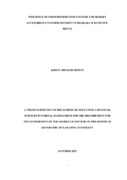| dc.description.abstract | Food distribution and market accessibility impact food security and development of rural economies. About 30% of Kenya’s population live in the country’s food insecure rural arid and semi-arid lands. Semi-arid Tharaka sub county suffers from insufficient and inefficient food distribution due to problems of physical accessibility to food markets which constitute main source of food items (86.95%) consumed here. These have led to sporadic and acute food insecurity across the sub county. The purpose of this study was to examine influence of local food distribution systems and market accessibility on food security in Tharaka sub county. Maize (96.6%) and millet (54.1%) are important staple food crops widely consumed by households in the study area. The objectives of this research focused on identifying biophysical and climatic factors that determine optimal maize and millet production for the realisation of food security; to determine how marketing models for maize and millet influence distribution and retention of food stock by households in Tharaka sub county; to examine efficiency of physical accessibility to existing open air markets and its effect on food security in Tharaka sub county, and finally to examine spatial distribution and utilisation of open-air markets in Tharaka sub county and its influence on food security. It was hypothesized that no significant relationship existed between agro-climatic suitability and maize and millet production, marketing models and food stock retention, markets physical accessibility and food security and how open-air markets spatial distribution influenced utilisation of the markets. A sample of 395 households selected using cross-section survey and a multi-purposive cluster sampling technique from the 31,556 households in the studt area were considered. Primary data was collected through observation, semi-structured questionnaires and 5 key informants’ interviews. GIS based modeling, Kendall’s multiple correlation analysis and Tobit regression techniques were used to analyse the data. Results of GIS agro-climatic suitability analysis in Idris Selva software showed that 4,189.31 hectares of land were suitable for optimised production of maize and millet. Identified suitable areas felled within the rainfed cropping zone (RFC) and mixed farming (MF) livelihood zones. Kendall’s multiple correlation analysis revealed that households living close to the markets (<5km) sold most of their food stocks retaining up to two bags for 3-4 weeks compared to those living away(>10km) who kept three to five bags for the same period or longer. Tobit regression analysis indicated education levels of household head and market price as important determinants in the choice of market models by a household. Lastly, ease of accessibility and service functional value influenced open-air markets preferential use by farmers and consumers alike. Conclusively, food security in Tharaka sub county is largely influenced by marketing models used by households to procure and sell foodstuffs, ease of physical accessibility to markets and the bio-physical and climatic conditions of the given livelihood cluster zone. In future, there is need to consider food distribution and market accessibility as determinant components of food security and nutrition improvement in the study area. Major recommendations from this study emphasize desire to promote food trade and market-based interventions to address food security. Furthermore, improving open-air markets’ physical infrastructure and construction of missing-link roads connecting villages to markets would address the problem of low food markets utilisation. | en_US |
